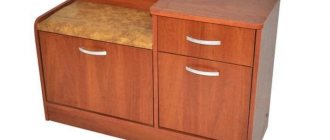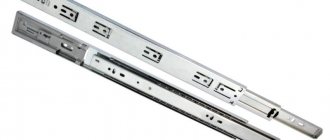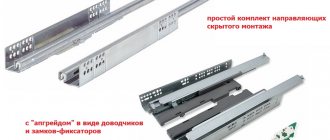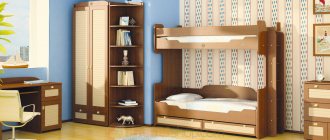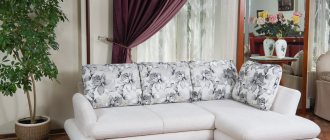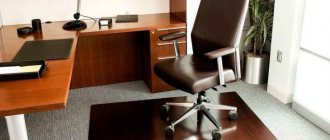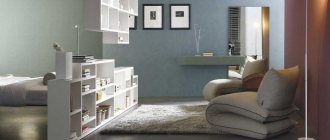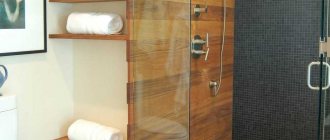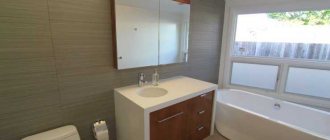Telescopic guides for drawers are modern fittings that allow you to effortlessly open even massive structures. Despite the fact that in almost any piece of furniture you can find drawers that can be pulled out due to the installation of special fittings, telescopic (or as they are also called ball) guides have gained great popularity only in recent years.
Today we will take a detailed look at their features and types, talk about how such fittings work, what advantages and disadvantages they have. We will also tell you step-by-step about the installation of telescopic drawer systems and simple repair of the guides, which you can do yourself.
Telescopic guides for drawers
Features of telescopic systems
Ball guides have a fairly simple design; their mechanism consists of main and auxiliary parts - these are metal runners and balls, as well as stopper elements and other limiters, which can be metal or plastic.
Telescopic guides are technologically advanced, durable fittings
This system greatly simplifies the operation process.
In order to understand the mechanism of their operation, we will consider the simplest version of two-section non-demountable telescopes. In this case, there are two rails that differ in size and are U-shaped, so that one part can fit into the other.
The mechanism is driven by moving metal tracks
There are small balls in the upper or lower part (between the parts), and the stopper is represented by the protruding edge of the rail. So in a certain area its movement stops.
The system received this name due to the fact that one track is placed inside another and extends like a telescope.
Drawer design with guides
The device consists of 2 “P”-shaped profiles, external and internal. The first is mounted on the wall surface in the interior of the headset. There are two grooves - upper and lower, into which plastic strips containing bearings are carefully placed. It is thanks to them that the profile slides inside. To prevent it from popping out completely, a special plug is installed.
At first glance, this seems incomprehensible, but if you follow the simple instructions given below, then everything will become extremely clear.
Two profiles are nested inside each other, and inside there is a carriage that ensures the sliding of the bar thanks to bearings - balls. The bar is attached to the drawer itself. So, the bar with profiles folds into one mechanism, and when they fold out again, the shelf completely slides out of the niche. The system is convenient, because this way you can get an item from the farthest corner of the furniture.
What types of ball guides are there?
Depending on the purpose, telescopic guides are distinguished by shape and other functions. Basically, they are divided according to the following characteristics:
- collapsible and non-dismountable mechanisms;
- two-section or multi-section (number of steps);
- multi-level or single-level.
The fittings have various mounting options
Telescopes can be installed both on the sides and in grooves
The difference between non-separable mechanisms is their rather low cost compared to analogues. This difference is due to some difficulties in the production of collapsible rails and a specific method of fixing the balls, because the structure must be designed in such a way that the guide can be disassembled without losing small elements.
Easy movement of boxes made of any materials is ensured by special balls
Of course, the cost is also influenced by the number of stages of the mechanism. This is also due to the peculiarities of the production of more complex parts.
Guides for this type of drawer come in a variety of colors, including black, steel, and zinc yellow. Balls are made of steel and nylon. It is worth noting that plastic balls are the quietest.
In most cases, drawers in cabinets with sliding doors are installed on telescopic guides
Design and principle of operation of ball guides
The main working elements of ball guides are:
- metal profiles, one of which is the base (rail), and the other is the carriage, moving along the main rail;
- rolling balls (separator), facilitating the movement of the carriage along the rail.
Ball type guide design
The advantages of ball guides are:
- smooth operation of the system;
- no noise when the box moves;
- high safety margin. Ball guides can withstand loads up to 65 kg;
- variety of models. Guides are manufactured with a closer, with the possibility of full or partial extension, and so on;
- resistance to natural wear due to the lack of contact between the main working elements of retractable fittings;
- ease of installation.
Among the disadvantages, one can note the higher cost compared to roller-type guides.
Advantages and disadvantages of ball guides
Any mechanism has certain advantages and disadvantages. Such features should be taken into account before choosing one or another fitting for installation.
Table 1. Pros and cons of installing ball guides
| Advantages | Flaws |
|
|
Telescope mechanism suitable for massive iron boxes
The role of ball guides in furniture production
Despite the fact that ball guides are used in various industries, such fittings are most popular in furniture manufacturing.
Most often they are installed in various wardrobe systems, chests of drawers, cabinets. This means that they can be found in any type of furniture that is designed for comfort and space saving. It is worth noting that the presence of such a system greatly simplifies the use of sliding cabinets.
A bed with drawers mounted on telescopic fittings
Installation of telescopic guides
We will consider the option of mounting telescopes using the example of the lower part of a kitchen table with drawers.
Calculations
At the very beginning, we need to determine the length and types of guides that will be used during further installation.
The basis will be a table of standard dimensions: length 520 millimeters and height 720 millimeters
The first type is a two-row incomplete extension design, and in our case such a mechanism will not work. The second type is the four row full extension slides which are perfect for this desk.
Next, you will need to determine the length of the sidewall, in this case it is equal to 520 millimeters, the type of back wall of the invoice. Even if the design assumes the presence of an inset wall, a 500 mm guide will still fit. Therefore, in any case, it will be optimal to choose exactly this length, but the method of fixing the back wall must be taken into account.
All calculations must be carried out starting from the facades
In this case, we will have 3 facades of 140 millimeters each and 1 facade of 292 millimeters. Calculating the length of the facades is quite simple. You just need to know the height of the case, which in this case is 720 millimeters.
This can be calculated using the following example, in the end we got 712 millimeters, which we divided into four facades
It should be borne in mind that each manufacturer has its own standard range of parts and most often the changes relate specifically to the height of the facades.
In order to correctly place the markings on the sides of the structure, it is necessary to consider the location of the drawers
Now you need to figure out how to calculate these dimensions. In this case, it is necessary to take into account the value of the lower indentation, which is 17 millimeters. So, the distance from the floor to the first box will be 25 millimeters, now you should add the height of half of this box, in this case it is 50 millimeters. The result was 75 millimeters.
The next size can be obtained taking into account the height of the lower facade. Here you should add 2 millimeters for the gap and another half from the other box. This is based on the fact that the boxes are 100 millimeters high and are located in the central part of the narrow facades, which are 140 millimeters high. Thus, 140 should be divided by 2 - it turns out 70 millimeters, which we add.
The next two calculations can be obtained by adding the previous ones
This means that 142 millimeters will need to be added to the dimensions that we have already received. Most often, the guides are installed before assembling the case itself, so you can simply subtract 16 millimeters from previous calculations or determine the values along the entire chain.
Next we will look at how to calculate the width of the drawers. In this case, our table length is 600 millimeters. Since in most cases laminated chipboard or MDF measuring 16 millimeters is used in furniture production, we will need to subtract 32 millimeters from the total width of the structure.
Determining the width of the drawers
In addition, from the resulting value of 568 millimeters, you will need to subtract another 26 millimeters for gaps.
Video - Installation of telescopic guides: calculations
Installation
Upon completion of all preliminary calculations, you can now move on to the practical part - installing telescopic guides.
The next two calculations can be obtained by adding the previous ones
Example of fixation on fiberboard
It is important to note one more digression - if you use guides on rollers, then the fiberboard bottom can be fixed to furniture nails. In the case of ball guides, it is recommended to use self-tapping screws as fasteners; in this case, you can also make an inset bottom.
Step-by-step instruction
Step one: the first thing we need to do is detach the inner part and attach it to the axle that divides our box into two parts. The guide has many holes for adjustment. In this case, we will start with longitudinal adjustment.
Attach the guide to the marking
Step two: you need to make a longitudinal adjustment so that the edge of the guide on the front is flush with the front edge of the side panel. After which you can already adjust the height.
Adjusting the location of the guide
Step three: after the work has been done, you need to begin installing the main part of the guide to the side of the table. Essentially, the mounting principle is the same, but in most cases there is no way to adjust the height. That is why when purchasing guides it is necessary to take this principle into account, because mechanisms with additional adjustment have a higher cost. Budget options were used here.
Installation of the main guide
Step four: the last step is to secure the drawers in place and check their functionality. You can insert all four drawers at once or one at a time.
Putting the boxes in place
Step five: the last step is to secure the facades. This should be done using double-sided adhesive tape and self-tapping screws (as shown in the image).
We install facades
There should be a gap of two millimeters between the facades. In order to make it, you should take a PVC edge tape of this diameter or any other object of the same width.
Furniture items
A few examples of furnishing a kitchen combined with a living room:
- 1. Sofa. It becomes an object that zones space. The sofa is placed with its back facing the place where food is prepared. In small rooms (less than 20 sq m) a corner is placed, which is placed against a wall installed perpendicular or parallel to the kitchen.
- 2. Set. According to designers, minimalist models without elaborate details look modern. The service, vases or glasses are placed on an open shelf. You can buy a fashionable display case for them. Furniture is placed near the wall. If the space is large (20 sq. m, 25 sq. m or 30 sq. m), then in the central part you can install an island, which also has sections for kitchen appliances.
- 3. Furniture set. The style should be combined with the design of both rooms. In small rooms, a compact table and chairs made of transparent material or painted in light colors look good. You can add a table with a round top to your living room interior. In spacious rooms, the kit is installed near the wall or in the central part. An elongated rectangular dining table would look good here.
Read here: DIY table made from cut wood - stylish and original ideas for creating tables and ideas for choosing their design (140 photos)
Repair of roller guides
Despite the fact that telescopic guides are considered the most durable compared to other options, in some cases failures occur. Of course, under such circumstances, you can replace the fittings, but it is still worth trying to repair it.
In this case, we will look at repairs using the example of full extension ball guides. The breakdown is that the plastic retainer has become unusable. It allows you to hold the box, thereby preventing it from jumping out of the rail.
Plastic retainer
Thin plastic can break during use, as happened in our case.
Of course, such a breakdown does not have any effect on the operation of the guide itself, but the box will not be fixed properly. Therefore, if you push it all the way, it will simply fly out. This, in turn, is unsafe because massive boxes can fall on your feet. That is why, if there is no stopper, they should not be pulled out.
Video - How to remove a drawer with ball guides
Telescopic guide repair instructions
Step one: you need to take a wire with a diameter of 2 millimeters. In this case, strong stainless steel wire is used, but you can use another one. At the same time, it should spring a little. In total, we will need to cut 9 centimeters from it (maybe a little longer or shorter) - this is the standard length of the clamp in any type of guide. The mechanism used here is 50 centimeters long, but it can be shorter.
Wire with a diameter of 2 millimeters
Step two: stepping back 1 centimeter, you need to make a bend at the end of the wire. Next, use a tape measure to measure another 2 centimeters from this bend and make another one.
The result should be something like this, which will now need to be bent in the opposite direction
Step three: now you should step back from the edge about 5 millimeters and bend it in the other direction. First, we get a small bevel, which will not be enough for a stopper, so we take another pliers. Next, we use two pliers to make the maximum bend.
Now we have a more durable clamp
Step four: you need to step back another 3 centimeters from this bend, and make another bend in the wire. The main thing is that all bends should be exclusively in the same plane, otherwise you will end up with a crooked latch that will not work properly.
Let's make a bend like this
Now, using pliers, you need to make such an eye at the end
Now you need to hammer in the latch using the same tool
At this stage our fixative is ready. Compared to a plastic product, it will last for many years, and besides, it is quite easy to make it at home. If desired, you can prepare a wire of 10 centimeters - a long clamp will work more smoothly.
How to remove a drawer
It is not difficult to pull out the structure: black clamps (tongues) are visible on the surface of the guides on the left and right sides. To completely release it, just hold these “flags” on both sides and lightly pull the handle in your direction.
The system may differ slightly on different pieces of furniture.
For example, if the furniture has telescopic guides with wheels, you just need to lift the bar so that the wheels come off the rail - the structure will slide out perfectly with minimal effort.
By performing each action sequentially, you can easily pull them out of the guides without damaging the structural elements.
If there are no “antennae” and wheels, the rail will simply have to be disconnected. The screws are unscrewed from one side and the other, and the shelf is pulled out.
In order to return everything to its place, follow the steps of this instruction in reverse order.
From the chest of drawers
Most often, you have to remove a shelf from a chest of drawers when there is a thing or object inside that does not allow the structure to be completely closed.
Having lowered the plastic holders on both sides and holding them in this position, begin to smoothly push the drawer to the end, pulling it out in this way.
It doesn’t matter whether there is a closer or not, the following actions are performed:
- pull the shelf towards you as much as the guides allow;
- press and slightly turn the plastic latch, which is located in the place where the hardware strips meet each other;
- Repeat the steps for the other side, pull the mechanism a little and pull it out.
You can only understand which model you have by trying to release the arrow. If it does not go down, then do not press harder, otherwise you will break and damage the structure. Just lift it up and everything will work out.
Note! If the latch is made of plastic, do not yank it too much - this will break the latch. You can use a thin screwdriver, but it is better to do everything carefully with your fingers. Do not pull the clamp completely out of the guide system!
On the retractable part there are special stoppers in the form of plastic tabs that prevent the structure from fully extending on its own.
Kitchen set
To open or remove a shelf on kitchen furniture, you will have to perform a number of these steps:
- empty the items and open the structure all the way;
- on the inner slot there is a black flag, made of plastic;
- press out the “tendril” using a small flat-head screwdriver: press it onto the flag and pull it towards you.
Important! The element should not be clamped too tightly - this could break the plastic. The flag can move either down or up on one side or the other.
- when the “tendril” goes beyond the end of the body, you cannot pull it out further. Try to lower the flag down; if that doesn’t work, move it up;
- simultaneously press the clamps on both sides and pull the box towards you.
You need to pull it out carefully so as not to bend the guides. The middle section should come out of the strip mounted to the wall of the compartment. Be sure to check the condition of the balls: they must be lubricated. If they are dry, lubricate them with the simplest grease.
Only with a correct understanding of how a thing works can you use it correctly.
Roller guides: what are their features?
In order to understand why many furniture makers choose telescopic guides, it is necessary to familiarize yourself with the structure of roller fittings.
Such mechanisms became available to a wide mass of buyers back in the 90s, when the first imported accessories began to be sold. In most cases, the products were manufactured in China, so they were not always of ideal quality, but there were exceptions.
Just a couple of decades ago, such mechanisms were considered very popular. They were used for furniture of any type, including cabinets, chests of drawers, and computer desks.
They are in the form of two planks, one of which is fixed to the wall of the structure, and the other to the box itself. The connection between them is represented by plastic rollers, thanks to which movement occurs.
Roller mechanism
The following positive aspects of installing roller guides can be noted:
- they are also distinguished by good strength;
- it is not difficult to repair such a structure yourself;
- they can be installed without the help of a professional technician;
- Guides of this type are characterized by a low price.
Roller guides are still used in budget furniture today.
In addition, the following negative aspects of installing such accessories are noted:
- it is impossible to pull out the drawers to the very end, because there must be some space left to connect the two parts of the guides;
- If installed incorrectly, there is a high probability of rapid breakdown of the mechanism;
- such fittings will not be able to support a box that is too massive, because the plastic rollers will simply break due to such pressure;
- plastic rollers wear out after a while - this leads to the fact that the drawers begin to constantly jam;
- less aesthetic appearance compared to telescopes.
Roller guides
Marking the mounting points for the guides
The principle of installing guides is much simpler than it might seem at first glance.
The telescopes (if you pinch the black antennae and pull out one half) can be disassembled into two parts, one of which is attached to the side of the drawer, and the second to the inner side of the chest of drawers.
Our main task is to determine the exact locations of these fastenings, screw each half with three screws and insert the drawer into the chest of drawers, thereby connecting the guide into one whole.
What other retractable mechanisms are there?
There are other drawer systems:
- Metaboxes. This is the name of the retractable mechanism, which is based on roller guides. The system assumes only partial extension to three-quarters of the entire length. Such a box should carry a load of no more than 20 kilograms.
- Tandems. The mechanism is an open type guide. The system provides partial extension and smooth operation. The advantage is that the box will be easy to dismantle without specialized tools.
- Tandemboxes. These are the most expensive guides. The kit contains components for installing fittings to the facade and rear wall. Such a system sometimes involves automatic opening of the drawer - all you need to do is press the front.
Drawer on Tandembox guides
Types and sizes
Progress does not stand still, and guide designs are improving along with it. If you study the modern furniture assortment, you can distinguish about seven varieties: from the most primitive and cheap to complex and expensive designs. With such a variety, everyone will find an option that is acceptable in terms of installation and cost.
Roller
Similar drawer guides appeared about 15 years ago and are still considered the most popular. Silent, smooth gliding is ensured by four rollers that move back and forth on special slats, as if on rails. They deserve their popularity because:
- easy to install;
- have a long service life;
- allow small flaws in the size of the box;
- do not require maintenance;
- cheap;
- sizes vary in length - from 200 to 600 mm.
To install them, unlike most analogues, you need to make two holes on both sides of the box and two in the mounting walls. To mark, just attach the strip to the wall. The load allowed by the manufacturer is no more than 20 kg. Roller guides require maintenance and are difficult to match to the color of the furniture.
An important advantage of rollers is that the box can be easily removed from the slats. Thus, it can be completely taken out and put back in a matter of seconds, which is very convenient during general cleaning.
With door closer
The market offers furniture guides with closers. Smooth movement here can be ensured by both rollers and balls. On the far side of the slats you can see two elements - the closer itself and the damper. He picks up the box at a certain distance and presses it all the way to the front. To prevent it from slapping against the side walls, a damper (spring) is used that provides slight resistance to the closer.
The advantages of guides with closers include:
- no popping sound;
- Just push the box and it will close tightly on its own;
- thanks to the small resistance, the drawers will not open if the furniture is not installed level;
- permissible load – up to 35 kg.
The disadvantages are a more complex installation technology and not the longest service life of the damper. After a couple of years, the spring may wear out and the mechanism will begin to “slap,” although expensive options are more durable. The design of guides with a closer involves a more complex installation procedure. Since the design of the products is one-piece and is not mounted separately, as in conventional rollers, correct marking is very important. For installation, each guide is “stretched” to its full length, exposing the mounting holes, and after that, places for drilling are outlined. First, the fittings need to be secured to the walls of the structure, and only then to the box. If you do the opposite, then you will no longer be able to get to the sides of the furniture.
Full classification of furniture bolts, selection criteria
Ball
Under significant loads, the rollers will not last long, but the ball guide can withstand up to 36 kg. If the bottom of the furniture allows, you can store up to 50 kg of items. As the name implies, the telescopic element slides due to the balls, that is, it is a kind of bearing. Only in this case there are two cassettes: one on the side of the wall, the second on the box.
Main advantages:
- can withstand more load than rollers;
- have a reliable design;
- quite cheap;
- You can disassemble it yourself by pressing a special lock.
Depending on the load and size of the drawer, ball guides are available up to 45 mm in height, and the smallest version is 17 mm. The length, like the rollers, varies from 200 to 600 mm. To install a collapsible ball guide, you need to remove the clamp and disassemble the structure into two halves. Then you should screw each one to the desired part of the furniture, insert one into the other. After this, together with the box, return the latch to its place. Another option is to extend the guide. After this, you need to screw on the “body” first, and only then the retractable parts. Disadvantages of such guides: labor-intensive installation, inability to fix furniture elements in a certain position.
Hidden mounting
Given the special design requirements, hidden-mounted guides are also growing in popularity. The discreet system makes the drawers appear to float in the air. Their installation is very complicated, and knowledge of the technology cannot be done without it. The point is this:
- guides are fixed to the walls of the structure;
- grooves are made in the back and side walls of the box;
- the retractable part is fixed to the bottom;
- Having threaded the box into the grooves on the pins, a special hook-shaped lock is turned.
Thanks to this fastening, the guides can withstand weights of up to 50 kg. This system is more expensive, but most models are additionally equipped with dampers and closers. Thanks to them, the drawers close quietly and smoothly.
Reverse action
The furniture industry also offers options developed for the sake of design. The point of reverse action slides is that drawers no longer need handles. When you press on the front part, the damper pushes out the structure so that it can be easily opened.
Tips for choosing wheels for furniture and rules for calculating loads
The advantages of such a system:
- attractive appearance, the absence of handles especially adorns glossy facades;
- reliable ball system;
- there are closers.
Installation is no different from rollers with a damper. The only caveat is that in the closed position the box must move 3 mm away from the edges of the walls so that the spring is activated when pressed. This system is not suitable for furniture in children's rooms, since a sharp push from the damper can injure the child.
Metaboxes and tandemboxes
A fairly new phenomenon on the European market, although it has been used in the USA for more than 10 years. The point is that the closers are also the side walls of the box. Advantages of these systems:
- ideal for industrial use;
- durable;
- have a damper and closer.
There is a drawback that becomes decisive for many - the high cost. Although metaboxes and tandemboxes have a common idea, their implementation is different. For the latter, all sides of the drawer are made of metal, have a closed roller design, and the furniture storage elements extend to their entire length. Metaboxes only open ¾ way. They are made of chipboard fittings, with only two walls made of metal. At the same time, the height of the box can be increased with special strips. Tandems can withstand up to 50 kg, metaboxes - only 20-25 kg.
Installing metaboxes involves dismantling the sides of the drawers, selecting guides of the required height and connecting the remaining elements. Roller slats are also installed on the walls of the housing. Tandemboxes have a modular design. The boxes themselves are assembled like Lego. Attaching the guides to the metal box follows the same principle as in the hidden installation system.
Full opening systems
The special “folding” design of the furniture guides allows you to open the drawer up to the back wall. For this purpose, a ball bearing and the required length of folding slats are provided. The system is convenient for furniture elements with great depth. The only negative is that full extension is possible if you apply a little effort; easy opening is expected only up to half.
Full extension guides are installed in almost the same way as other types. First, the latch is removed and the structure is disassembled. After this, one part is attached directly to the boxes, the second is screwed to the walls of the product, and then connected.
Let's sum it up
You should choose one or another type of retractable fittings based on the design features of the furniture and your personal preferences. At the same time, if you want to get a durable mechanism, then you should not save money on its purchase, because low-quality guides quickly jam and stop functioning. The best option today is a telescopic system, and the installation of such fittings can be done without the help of a specialist - you just need to have all the necessary tools and fasteners on hand.
